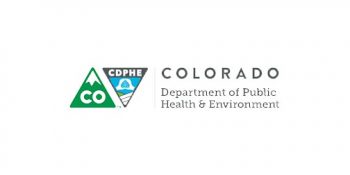The Colorado Department of Public Health and Environment has issued an ACTION DAY ALERT FOR OZONE AND FINE PARTICULATES at 4 PM on Monday, September 4, 2017 for the Front Range Urban Corridor from El Paso County north to Larimer and Weld counties, including the Denver-Boulder area, Colorado Springs, Fort Collins and Greeley.
Widespread wildfire smoke will result in ozone and fine particulate concentrations reaching the Unhealthy for Sensitive Groups category, and for some areas in the northern Front Range fine particulates will reach the higher Unhealthy category.
This Action Day Alert will remain in effect until at least 4 PM Tuesday, September 5, 2017.
For statewide conditions, forecasts and advisories, visit:
http://www.colorado.gov/airquality/colorado_summary.aspx
At 1PM (MST), Monday, 9/4/2017 the highest AQI value was 150 for Particulate FRONT RANGE AIR QUALITY FORECAST:
Monday, September 4, 2017, 2:00 PM MDT
Ozone concentrations are expected to be in the Moderate to Unhealthy for Sensitive groups range on Monday and the Good to Moderate range on Tuesday. Ozone concentrations in the Unhealthy for Sensitive Groups category on Sunday are most likely from the western suburbs of the Denver metro area northward along and near the foothills to Ft. Collins. Please refer to Fine Particulate Matter below for health recommendations on Monday and Tuesday.
Fine Particulate Matter concentrations are expected to be in the Moderate to Unhealthy range on Monday and Tuesday.
— Fine particulate concentrations in the Unhealthy category are most likely for northern Front Range locations such as Ft. Collins, Greeley, Longmont and Boulder. In those areas, People with heart or lung disease, older adults, and children should avoid prolonged or heavy exertion until midnight Monday night, and then should reduce prolonged or heavy exertion through at least noon on Tuesday.
— For all other Front Range locations, including Denver and Colorado Springs, people with heart or lung disease, older adults, and children should reduce prolonged or heavy exertion until at least noon on Tuesday.
Carbon Monoxide concentrations are expected to be in the Good category on Monday and Tuesday.
Nitrogen Dioxide concentrations are expected to be in the Good category on Monday and Tuesday.
Visibility on Tuesday is expected to be Moderate.
COLORADO SMOKE OUTLOOK:
Monday, September 4, 2017, 2:00 PM MDT
Air Quality Health Advisory for Wildfire Smoke
Issued for areas below 7000 ft. in eastern Colorado Issued at 9:30 AM MDT, Monday, September 4, 2017
Issued by the Colorado Department of Public Health and Environment
Affected Area: Areas below 7000 ft. in eastern Colorado. Locations include, but are not limited to Denver, Boulder, Ft. Collins, Greeley, Colorado Springs, Pueblo, Ft Morgan, Sterling, Julesburg, Holyoke, Boulder, Broomfield, Brighton, Littleton, Akron, Wray, Castle Rock, Kiowa, Hugo, Burlington, Cheyenne Wells, Ordway, Eads, La Junta, Las Animas, Lamar, Trinidad and Springfield
Advisory in Effect: 9:30 AM MDT, Monday, September 4, 2017 to 9:00 AM MDT, Tuesday, September 5, 2017
Public Health Recommendations: If smoke is thick or becomes thick in your neighborhood you may want to remain indoors. This is especially true for those with heart disease, respiratory illnesses, the very young, and the elderly. Consider limiting outdoor activity when moderate to heavy smoke is present. Consider relocating temporarily if smoke is present indoors and is making you ill. If visibility is less than 5 miles in smoke in your neighborhood, smoke has reached levels that are unhealthy.
Outlook: Moderate to heavy smoke from fires in the northwestern US and western Canada is being transported into eastern Colorado. Smoke will slowly decrease Monday afternoon and evening, however due to the lingering health impacts of fine particulate concentrations we urge the public to continue to follow the health recommendations listed above through at least Tuesday morning.
The 710 acre Big Red wildfire is located in northeast Routt County, approximately 15 miles north of Clark, near the western edge of the Mt. Zirkel Wilderness area. Winds near the fire will be from a north to northwesterly direction through Monday evening. Smoke produced by this fire will likely be transported to the south or southeast of the fire, mainly impacting rural parts of Routt and JacksonCounties. No public health impacts are expected, however smoke may be visible from Highway 129 near Steamboat Lake State Park and between Clark and the Colorado/Wyoming State line. Overnight, drainage winds will allow smoke to reach lower terrain, immediately below the fire. Locations affected by smoke during the overnight and early morning hours are likely to be along the Middle Fork Little Snake River drainage in the vicinity of Big Red Park and Crane Park; and in remote areas of rural RouttCounty. Light to moderate smoke is also possible near prescribed fires and small wildfires around the state.
What if there is a wildfire or smoke in your area?
The focus of the Colorado Smoke Outlook is on large fires (e.g., greater than 100 acres in size). Nevertheless, smoke from smaller fires, prescribed fires, and/or smoke from new fires not yet known to CDPHE air quality meteorologists may cause locally heavy smoke. If there is smoke in your neighborhood, see the public health recommendations below.
Public health recommendations for areas affected by smoke: If smoke is thick or becomes thick in your neighborhood you may want to remain indoors. This is especially true for those with heart disease, respiratory illnesses, the very young, and the elderly. Fine particulates may reach the Unhealthy category where smoke is heavy. Consider limiting outdoor activity when moderate to heavy smoke is present. People with heart or lung disease, older adults, and children should avoid prolonged or heavy exertion; everyone else should reduce prolonged or heavy exertion. Consider relocating temporarily if smoke is present indoors and is making you ill. IF VISIBILITY IS LESS THAN 5 MILES IN SMOKE IN YOUR NEIGHBORHOOD, SMOKE HAS REACHED LEVELS THAT ARE UNHEALTHY.

Leave a Reply